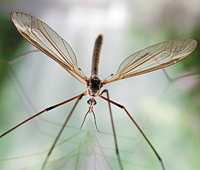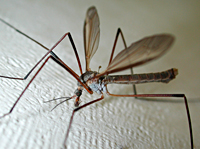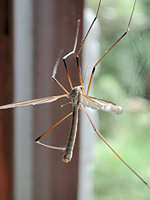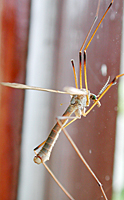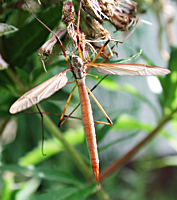[All pictures of garden wildlife on this page are thumbnails. Click on any thumbnail for a large format to be displayed.]
European Crane Fly (Tipula paludosa)
Tipula padulosa is relatively easy to photograph as it can stay motionless for hours at the same spot.
The European Crane Fly is about 3 centimeters in length. The females wear no striking marks. The males do have colourful patterns but because they vary a lot and are sometimes even absent, it is impossible to define them. The female has a sharply pointed abdomen that is used to push the eggs in the ground.The adults appear only once a year during a short periode of time in August and September. The European Crane Fly is a rather clumsy flier and it doesn't actually fly much. When a female is carring eggs, it can hardly fly at all. The eggs are being laid in great numbers at a single spot. The larvae, which may be up to 4 centimeters, are called leatherjackets. They are responsible for quite some damage in a lawn because it eats the roots of grass. And the lawn is most effected at times it is most vulnerable which is in winter. The larvae of the European Crane Fly are extremely able to sustain winter conditions and remain active even in spite of severe freezing temperatures. The adults are absolutely harmless as they don't eat anything at all.
This species is common all over Western Europe. It has also invaded the United States, where it is considered a real pest.
The lower section of the abdomen betrays the sex of Tipula paludosa. Left: a male. Right: a female with sharply pointed abdomen.

© Copyright 1998-2024 gardensafari.net (Hania Berdys)

 English / engels
English / engels  Dutch / nederlands
Dutch / nederlands
